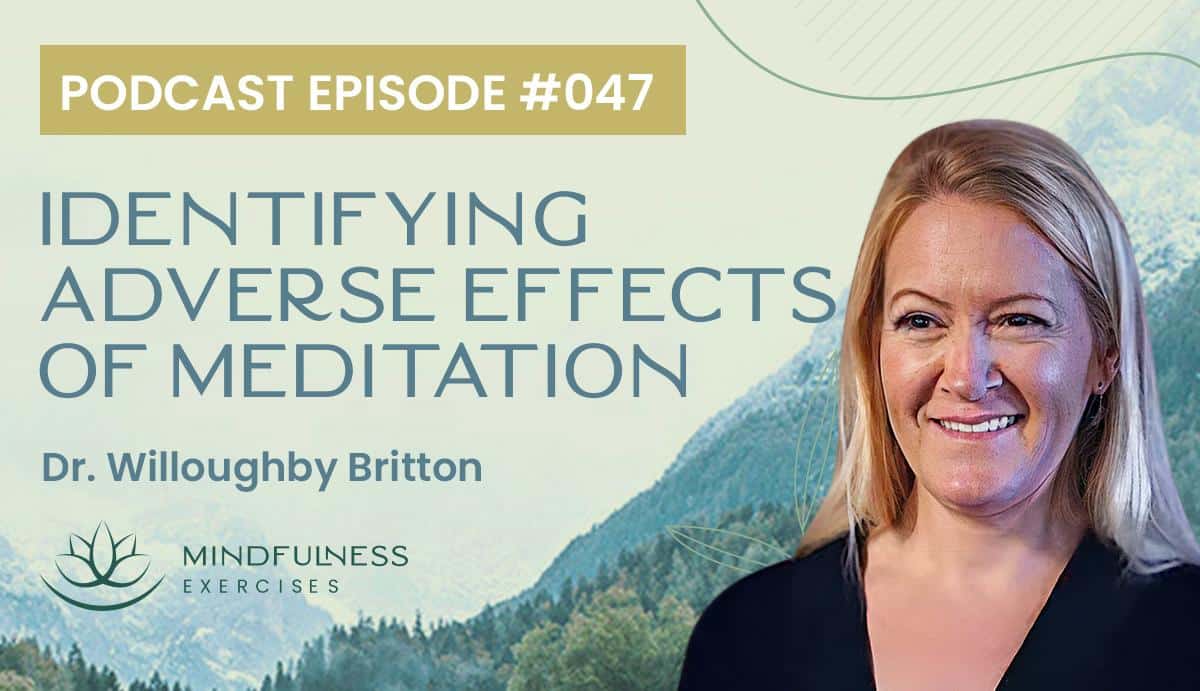Listen now

Meditation’s benefits are often overhyped, while its discomfort, challenges, or ongoing adverse experiences tend to be little mentioned - even though the latter happens to around 1 in 10 meditators. This disparity can leave those who struggle with meditation feeling very alone and unsure where to find help.
In this episode, we hear from clinical psychologist, professor and mindfulness expert Dr. Willoughby Britton. Willoughby presents a thorough, research-based overview on how to identify the adverse effects of meditation. She explains which ones are most likely to happen during mindfulness-based meditations. Perhaps more importantly, she offers both practitioners and teachers suggestions on what to do and where to go for help with the challenges of contemplative practice.
Sponsored by our Mindfulness Meditation Teacher Certification Program
MindfulnessExercises.com/Certify
What You’ll Learn in This Episode:
Show Notes & Quotes:
The difficulty of measuring meditation’s adverse effects
Understanding how many people experience adverse effects from meditation is difficult. Meditation’s benefits are often over-emphasized while its adverse effects are rarely studied. In a meta-analysis of over 12,000 meditation studies, just 1% measured adverse outcomes. In addition, what defines an adverse effect has not been standardized.
“The definition of ‘adverse effect’ is going to determine the frequency. And everybody defines it differently. [...] The percentage, the frequency, is all over the place depending on how you define ‘adverse effect.’ And so, you can see that there’s up to 90% of people have adverse effects. If you define an adverse effect as seeking medical treatment it’s 6%, so it’s all over the place.”
Discerning between side effects and adverse effects
Willoughby’s research defines three types of meditation-related adverse effects. There are those that occur during meditation only, those that impact one’s life and functioning, and those that have a negative impact lasting longer than just a few days or weeks. Willoughby’s research focuses specifically on the latter two. However, these adverse effects are different from ‘side effects,’ which are not necessarily negative.
“A side effect is any effect outside the intended goal of whatever you’re advertising. So if you’re advertising stress reduction, it’s anything outside of that. Any category of these varieties of contemplative experience study, and any valence. It could be positive, negative or neutral. So side effects don’t have to be negative, they can be positive too.”
Common experiences mistaken for adverse effects
Meditation is not always a relaxing, feel-good experience, but beginners to the practice may not know this. In Willoughby’s study on mindfulness-based cognitive therapy, 83% of participants reported an unusual experience. Although this was not surprising to researchers, it can feel uncomfortable for students, especially if they had different expectations.
“The unpleasant experiences, or transient stress during meditation, this is also extremely common. Meditation is not always relaxing, people should know that. This can be managed with expectations, what people expect when they come, and just to know that it’s not always relaxing. So I don’t personally consider these adverse effects. I think adverse effects are when it starts to impact your life off the cushion.”
The true prevalence of meditation-related negative outcomes
With a more clear definition of adverse effects in hand, Willoughby and her team set out to research the true prevalence of life-impacting adverse effects following meditation. The first surprising result was that their epidemiological sample indicated nearly half of the US population has meditated at least once. Of these people, 6-14% had lasting negative effects, a number that closely mirrors the adverse effects of psychotherapy (5-13%).
“The one number to remember was that if you’re thinking about frequency, you should say at least 10%. At the very minimum you’re going to see 10% of people who are having an adverse effect - that you need to worry about, that needs some kind of attention from the teacher. 1 out of 10.”
Which types of adverse effects are associated with mindfulness
In her 2017 study on the varieties of contemplative experience, Willoughby and her team used a codebook of 59 categories of potentially challenging meditation experiences. Those that are most often seen in mindfulness-based programs may be grouped into the categories of hyperarousal (such as anxiety, agitation, re-traumatization), hypoarousal (such as dissociation or emotional numbing) and a hybrid of the two (such as executive or social impairment).
“In my study, these are the things that participants rate as having a negative impact on their functioning outside of meditating. [...] And then we re-ran the analysis to look at, statistically speaking, which symptoms predict lasting bad effects, lasting impairment.”
The adverse effects teachers should watch for more closely
Many people recognize anxiety, agitation, panic or sleeplessness as a negative effect. These are each associated with hyperarousal. Those that are associated with hypoarousal aren’t typically experienced as negative. This means students are less likely to report these to the teacher. However, it does not mean hypoarousal symptoms, such as dissociation, won’t have a negative impact on one’s life.
“In the case of dissociation, many people don’t mind dissociation so they're not judging it as negative, but it will still lead to an impairment in functioning. Another thing to notice is traumatic re-experiencing didn’t actually increase risk for impairment or problems. So that means that even though we’re very focused on trauma-informed, or re-experiencing trauma as this thing that we need to watch out for, our data suggest that it’s not actually as problematic as other symptoms to watch for. [...] I would look more for dissociation.”
The neurological mechanisms behind the middle way
Physiological and psychological processes have an optimal level. Just as there’s an optimal level of arousal, there’s also an optimal level of mindfulness. This is often represented by an inverted U-shaped curve: Too much arousal leads to anxiety, too little and we become sleepy. The key is balance to keep ourselves in the middle.
“The systems of the brain that are involved in attention are also involved in arousal. [...] If you think of meditation as an attention enhancing drug that changes your brain, which it does, you can overdo it and start to have too much cortical arousal.”
The overlapping neural correlates behind benefits and detriments
The same neurobiological mechanisms that drive meditation’s benefits are responsible for its adverse effects. Meditation improves anxiety, for example, by upregulating areas of the brain related to depersonalization. Activate these same areas too much, and we begin to dissociate. Downregulate the amygdala and we become less reactive to stress. But go too far, and all our emotions become numbed.
“Often you hear, especially in the mindfulness world, that increases in insula activation are associated with enhanced interoception or body awareness. And that’s true. But what they don’t tell you is that it’s also associated with arousal, emotional intensity. If you stimulate the insula cortex you can induce terror, fear. It’s also a marker of anxiety and PTSD and flashbacks. So going back to our ubiquitous u-shaped curve, you can have an optimal level of insula activation or body awareness.”
Practical advice and additional resources
In addition to the practical advice offered throughout the podcast, Willoughby shares several resources for those experiencing adverse effects following meditation, or for anyone trying to help others navigate their way through a balanced practice. Willoughby is the founder of Cheetah House, which offers support to meditators in distress. Their resources include research, on-demand and live videos and teacher trainings. To date, they have served over 20,000 people worldwide.
Additional Resources:

About Willoughby Britton:
Dr. Willoughby Britton is a clinical psychologist and associate professor at Brown University’s medical school. She is the Director of Brown’s Clinical and Affective Neuroscience Laboratory which investigates the psychophysiological and neurocognitive effects of meditation and mindfulness-based interventions for mood and anxiety disorders. She is specifically interested in which practices are best or worst suited for which types of people or conditions and why.
Dr. Britton is the founder of Cheetah House, which provides support to those experiencing meditation-related difficulties, trains meditation providers in understanding and treating meditation’s adverse effects and empowers people to make informed decisions about the role of meditation in their lives.
Willoughby is a licensed clinical psychologist and as a clinician has been trained as an instructor in Mindfulness-Based Stress Reduction (MBSR) and Mindfulness-based Cognitive Therapy (MBCT), and has taught mindfulness to both clinical and non-clinical populations, and in federally-funded clinical trials.



